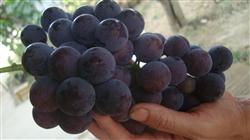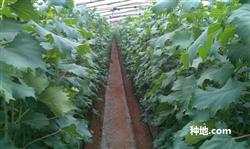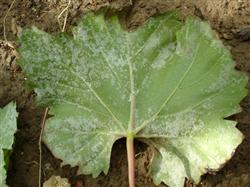How about Hutai No. 8 grape?

How about Hutai No. 8 grape? Where is Hutai No. 8 grape suitable for planting and how to plant it well? Hope that experienced friends can help introduce the data and planting techniques of Hutai No. 8 grape. The following is a list for netizens' reference. Hutai No. 8 grape variety characteristics: Hutai No. 8 grape, rich flavor, excellent taste, fruit sugar content of up to 17mur20%, general grain weight 12Mel 18g, ear weight 600Mel 800g. The root system of Jufeng grape is stronger and stronger than that of general grape. Hutai No. 8 grape has borne fruit many times a year, but the tree does not decline, the branches are abundant when overwintering, and the degree of aging is still higher than that of ordinary varieties. The grape has compact panicle type, thick pericarp and excellent storage and transportation performance. Under the condition of high temperature in summer, the shelf life can reach more than 10 days without refrigerating treatment, and it is still fresh. Hutai No. 8 has stronger cold resistance than ordinary grape varieties and has strong resistance to black pox, white rot and downy mildew. The yield of Hutai No. 8 grape: generally, the yield per mu is about 1500 kg. The yield of secondary fruit is 500m / mu and 600kg / mu, and it can bear fruit for three times when the climate is suitable, and the ear weight and grain weight of each fruit are the same, and the color and fragrance are good, there is no difference. Environmental requirements of Hutai No. 8 grape: introduction of adaptability and stress resistance of Hutai No. 8 grape: it is suitable for cultivation in most parts of the country. The accumulated temperature of ≥ 10 ℃ per year is 3800 days, and the frost-free period is more than 180 days. The plant is resistant to high temperature, can still grow when the daily maximum temperature is 38 ℃, and has strong resistance to downy mildew, gray mildew and anthracnose. The planting and management methods of Hutai No. 8 grape are as follows: 1. The requirements for the establishment of the garden: the row spacing is 1.5 × 2.8m, and the height, width, vertical T frame or three-line Y frame is adopted, which is the most suitable for the management. Plastic surgery can be completed in two years. 2. Fruit quantity control: this variety has high yield and strong fruiting ability for many times, so the fruit quantity should be strictly controlled. It is appropriate to keep 750 Mu per mu of primary fruit and 1250 Mu of secondary fruit per mu, and the annual yield per mu is more than 2000 kg. 3. Fertilization and irrigation requirements: Hutai No. 8 grape should apply sufficient basic fertilizer and strengthen topdressing. The water control period is from 10 days before the fruit blossom to the whole flowering period, except for the fruit coloring period in late June, other times should be irrigated timely according to the situation. 4. The principle of pest control: the variety has strong disease resistance, and no obvious diseases and insect pests have been found after several years. In production, early prevention and early treatment, combination of prevention and control and comprehensive control should be achieved according to the occurrence law of grape diseases and insect pests and the characteristics of the variety. 5. Hutai No. 8 grape shaping and pruning method: winter pruning operation: one fruit mother branch is left on the main vine every other 30-40cm, and the result mother branch is on both sides of the main vine. Each plant has a total of 7 fruit mother branches. The medium and short shoots are pruned, and each fruit mother branch has 2 color and 4 buds. Results the cutting thickness of the mother branch was more than 0.9cm. The length of the extended head is not more than 1m. At present, Hutai No. 8 is mostly managed by a V-shaped frame, with a line spacing of 2.5 meters, a plant spacing of 0.8 meters, and 330 plants per mu of land. This type of frame is easy to manage, easy to operate, and can produce results in the second year. Summer pruning operation: (1) wiping buds: erase bad buds and twin buds and medium-weak buds. (2) fixed shoot: the branches with good growth and large inflorescence were selected according to the planned yield. Before the vines climb all over the frame, the first and second wires can leave fruit branches to ensure early yield. Don't stay after climbing all over the rack. (3) coring and removal of accessory shoots: coring is usually carried out one week before flowering, preferably 2 weeks before flowering, and the upper part of the branch above the size of walnut leaves is removed. Two secondary shoots were left at the top of the new shoots, and the rest were all erased or left 1 Mel 2 leaves below the inflorescence to pick the heart repeatedly. The accessory shoot at the top of the new shoot leaves 5 leaves to pick the heart repeatedly. Hutai No. 8 grape fruiting period management method: ear thinning operation method: according to the high quality fruit standard, the grape yield should be controlled at about 1500 kg per 667m, and the fruit per ear should be kept at about 750g, that is, 1500Mel 2000 ears should be retained per 667m. If 150 plants are planted per 667 m ~ 2, the average number of ears per main vine is 5m ~ 7, and there are 15 ears per plant, and the excess ears can be thinned. Go to the accessory ear and pinch the ear tip to straighten out the ear sandwiched between the branches and make it droop naturally. The ear length is 12ml 15cm, the longest is not more than 20cm, so that the whole ear is tight but not squeezed, loose but not loose. Grain thinning operation method: remove small grains, deformed grains, injured grains and fruit grains that are too tight and squeeze each other on the ear. In order to save labor, some spikelets on the rachis can also be removed. There are about 50 grains per panicle, and the average grain weight is 14-15g, which can guarantee about 750g per panicle. Bagging: in order to ensure that the ear is not polluted by pesticides, reduce the harm of diseases, insect pests and birds, prevent the ear and leaves from rubbing and injuring the fruit surface, avoid sunburn and excessive color, and prevent the fruit surface from being damaged by cracking and hail, after thinning, the ear should be bagged in time. Before bagging, spray Bordeaux liquid of 0.7 and 200 Bordeaux once on the ear that has been thinned. After the fruit surface is dried, put on the paper bag, fasten the upper mouth of the paper bag and fix it on the old vine, and leave a vent at the two corners of the lower mouth for ventilation. Paper bags are generally 33 cm long and 30 cm wide. Single-layer paper bags soaked with fungicides for grapes should be selected. The bagging time is around June 20. Click to get more grape planting techniques click to get more fruit planting techniques
- Prev

How to manage growing grapes in greenhouse
How to manage growing grapes in greenhouse? Ask for advice greenhouse grapes listed early, can be listed two months in advance, supplement the off-season supply of fruits, high unit price, can obtain high yield and high efficiency, with an average annual income of 20,000-30,000 yuan / mu, is a good way to get rich in rural areas. The cultivation techniques are introduced as follows: 1. Variety selection. Pass through.
- Next

Grape management techniques: what is grape downy mildew?
What is grape downy mildew? What harm does downy mildew have to grape? How to prevent grape downy mildew? Please also help guide the cultivation network summarized the harm and prevention methods of grape downy mildew, listed below for the reference of netizens. Downy mildew damage to grapes: grape downy mildew mainly damage leaves...
Related
- Moge, come on! The staff of the peasant association in the producing area of cantaloupe were frightened when the crowd gathered.
- Causes and Solutions of low Fruit setting rate of Apple
- Symptoms and control measures of passion fruit virus disease
- Fruit growing lesson: how do apple orchards keep high yields?
- Can you build orchards in the mountains? What are the pros and cons?
- How to manage the coloring period of Crisson grape?
- This paper introduces the processing technology of two kinds of fig products.
- How much is a month for retired teachers in rural areas by 2020?
- How can strawberry planting increase sugar content? We should pay attention to management in many aspects.
- What are the cultivation techniques on how to improve the yield of golden fruit?

